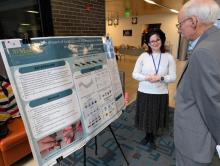
St. Mary’s College of Maryland Professor of Biology Jeffrey Byrd recently published a paper on the “Guidelines for Biosafety in Teaching Laboratories Version 2.0: A Revised and Updated Manual for 2019” in the Journal of Microbiology & Biology Education, along with colleagues Elizabeth Emmer of Salisbury University, Robert Maxwell of Georgia State University, and Heather Townsend of Rhode Island Community College.
According to the paper, the original Guidelines for Biosafety in Teaching Laboratories, published by the American Society for Microbiology (ASM), were developed in 2012 in response to an outbreak of Salmonella tracked by the Centers for Disease Control and Prevention (CDC) that originated from clinical and teaching microbiology laboratories. An updated version was deemed necessary by ASM to eliminate redundancies, include stronger wording, and emphasize risk assessment.
The new version also includes new information on guidelines determining admittance of service animals into a laboratory and are aimed as a starting point when instructors work with ADA compliance officers to determine reasonable accommodations.
Byrd, who serves as the safety editor for the Journal of Microbiology & Biology Education, said prior to 2012 there weren't any concrete biosafety guidelines for teaching laboratories as there have been for research labs. Byrd was on the ASM Task Committee that developed the original guidelines and chaired the committee for the revised version. He said the committee was comprised of experts representing all levels of colleges such as liberal arts, large and small colleges, and community colleges.
Stronger wording on the necessity to adhere to the guidelines was used in the new version as these are the guidelines that are expected to be adhered to by individuals working with microbes in teaching laboratories and have been referred to in CDC reports.
An emphasis on risk assessment was one of the major updates to the guidelines.
The biggest worry, Byrd explained, was “we can be very good in the laboratory but if we’re not thinking about what might be leaving our laboratory, that is where safety mindset is necessary.” The risk assessment portion of the guidelines helps instructors think about the organism used in the lab, what will be done with it and the risk involved as these are all factors that can change the biosafety level at which one has to work with that organism. Byrd said students in the lab may not be aware of these inherent risks.
“Students are novices. We cannot assume that they will be able to apply their training to novel situations,” he said. He said microbes are a very useful tool and are easy to work with, “we just have to understand how we are working with them and do a risk assessment of the procedures we will use.”
The new manual, similar to the original, contains sections on personal protection requirements, laboratory physical space requirements, stock culture requirements, standard lab practices, training practices, and document practices. Each section of the updated manual includes guidelines for biosafety level one (lab settings working with low level microbes), and biosafety level two (lab settings working with pathogenic organisms), allowing the reader to see in one place expectations at each level. Byrd explained that students should always be trained with an organism that is not pathogenic before using a pathogen for that same technique.
For more information and to see the ASM Guidelines for Biosafety in Teaching Laboratories, visit https://www.asm.org/



